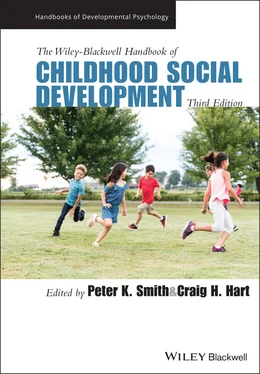55 Wyness, M. (2020). The responsible parent and networks of support: A case study of school engagement in a challenging environment. British Educational Research Journal, 46(1), 161–176.
56 Young Women’s Trust (2017). What matters to young mums? Young Women’s Trust.
57 Zahn‐Waxler, C., Shirtcliff, E. A., & Marceau, K. (2008). Disorders of childhood and adolescence: Gender and psychopathology. Annual Review of Clinical Psychology, 4(1), 275–303.
CHAPTER SEVEN Anthropological Perspectives on Social Development
Heather Montgomery
While rarely referred to as “social development” within anthropology the ways that children develop and learn about their worlds, how they interact with others and how, through these interactions, grow up to be competent and successful members of their societies and cultures, have been much studied by anthropologists. There is a long‐standing interest in socialization, particularly among American anthropologists, who have focused on how childrearing practices shape children’s identities and social development and, more recently, on how children learn the skills necessary to work and contribute to their communities. This work has developed in parallel with psychology, drawing heavily on the findings and insights from social psychology and contributing cross‐cultural perspectives and examples to discussions of how children learn and develop. There is an excellent summary and discussion of this work in LeVine (2007), and an invaluable reader with extracts from core texts in the field edited by LeVine and New (2008).
There is also another more recent development in anthropological thinking about childhood, closely linked to the New Social Studies of Childhood movement that developed in Europe in the 1990s (James & Prout, 1997). Anthropologists pursing this strand of theorization and research are less interested in studies of socialization, and how parents raise children, and are more concerned with the importance of children as agents, social actors, and informants: as human “beings” rather than human “becomings.” Children, within this paradigm, are of interest to anthropologists for their lives and experiences as children, rather than their future as fully developed adults. This theorization is based on the idea that “the child” is a social construction rather than a universal biological entity. It has been largely critical of psychology, dismissing it as ethnocentric and future focused and instead draws on politics, especially ideas of children’s rights, to frame discussions of children’s experiences (Montgomery, 2009).
In this chapter I will discuss these two different “anthropologies of childhood” and look at how they have both contributed to understandings of children’s social development – and problematized them. I will then look at the tensions between them, as well as areas of contemporary and future overlap, and at the benefits of combining multiple perspectives to create vibrant and holistic studies of childhood which move beyond disciplinary backgrounds.
Anthropology, Child Development, and Cross‐Cultural Studies of Childrearing
From the earliest days of the discipline, studies of child development were central to North American anthropologists. Franz Boas (1916), for example, used studies of child development to chart the environmental impact of human physiology among immigrants to America. His interest in children and young people also had a profound influence on his student, Margaret Mead, who became for many decades the most prominent figure in anthropological studies of the social and cultural development of children. It was with Boas’s encouragement that Margaret Mead began her studies of Samoa (1928) and New Guinea (1930), focusing her attention on children and young people, looking at how they were brought up, and the effects that their upbringing had on their adult personality and behavior. In her work she analyzed the daily lives of Samoan girls from infancy through early childhood, adolescence, and beyond, describing a stress‐free passage through life without the tensions and disruptions at particular life‐stages (especially adolescence) that Western psychologists claimed to be universal behaviors and developmental norms. Mead argued that any such behaviors were as much culturally learned as biologically innate and that patterns of socialization, rather than physical changes, were key to understanding children’s social development. Although Mead was subsequently heavily criticized for both her methodology and her interpretation (see Freeman, 1983), Coming of Age in Samoa (Mead 1928) has remained in print ever since and its popularity amongst both psychologists and anthropologists, as well as its explicitly comparative stance, continues to be influential and important in understanding the cross‐cultural differences in children’s development.
Although Margaret Mead’s influence declined in American anthropology in the 1950s, studies of childrearing and socialization continued through the work of John Whiting and others. After fieldwork in Papua New Guinea, Whiting turned his attention to cross‐cultural research, focusing his interest on broader patterns of human behavior, and their links to childhood experiences. Using material from the Human Relations Area Files (HRAF), the immense database of ethnographic information set up in 1949 by George Murdock at Yale as a way of making statistical cross‐cultural comparisons, Whiting and his collaborators set out to undertake systematic analyses of childhood experiences, the impacts they had on their social development and the effects they then had on adult society.
Whiting and his co‐researcher Irvin Child, in Child Training and Personality published in 1953, attempted to apply Freudian theories about the stages of a child’s psychosexual development to ethnographic data. Using information from 75 societies, they focused on three particular aspects; weaning from the breast, toilet training, and sexual management, stages which Freud had labelled oral, anal, and phallic and which, he claimed, always occurred in that order. In looking at the ethnographic evidence however, Whiting and Child found that these were not salient variables in many societies and did not always occur in the order Freud had suggested (Whiting & Child, 1953). Furthermore, in many cases, weaning from the breast or toilet training were regarded as relatively unimportant while “weaning from the back” (when a child was no longer carried by the mother or care‐giver), and the management of aggression, were considered more significant and relevant markers in child socialization. Having concluded that parents in most cultures were more concerned with interpersonal relations and social development than they were with bodily functions, Whiting and Child dropped the idea of temporal stages in favor of behavior systems, which they defined as “oral, anal, genital, training for independence and for the control of aggression” (J. Whiting, 1994, p. 24). They found correlations between each of these behavior systems and other factors such as the degree of initial indulgence, the age at onset of overt discipline, the severity of socialization and the techniques of punishment used by parents. Whiting spent the next four decades studying childrearing and socialization in as scientific and comparative way as possible, testing specific hypotheses about the links between particular aspects of social life; for example, he looked at how a combination of practices, such as a boy sleeping exclusively with his mother, and a taboo on sexual relations between parents for a substantial period after birth, might lead to a boy’s strong identification with his mother and a hostility towards his father; an Oedipal situation which could only be resolved by elaborate rituals at puberty including circumcision (Whiting et al., 1958).
Читать дальше












